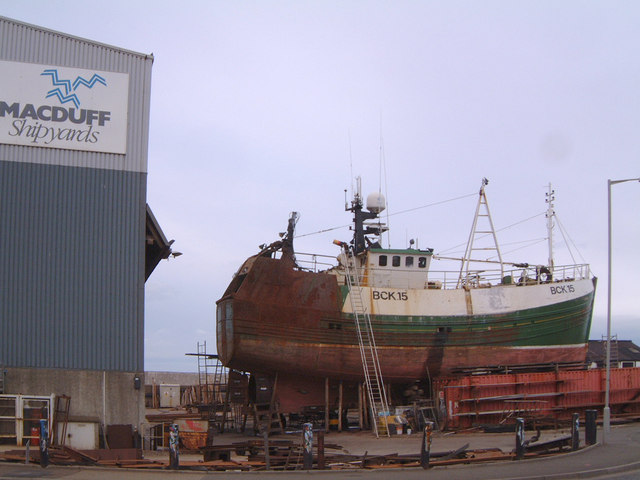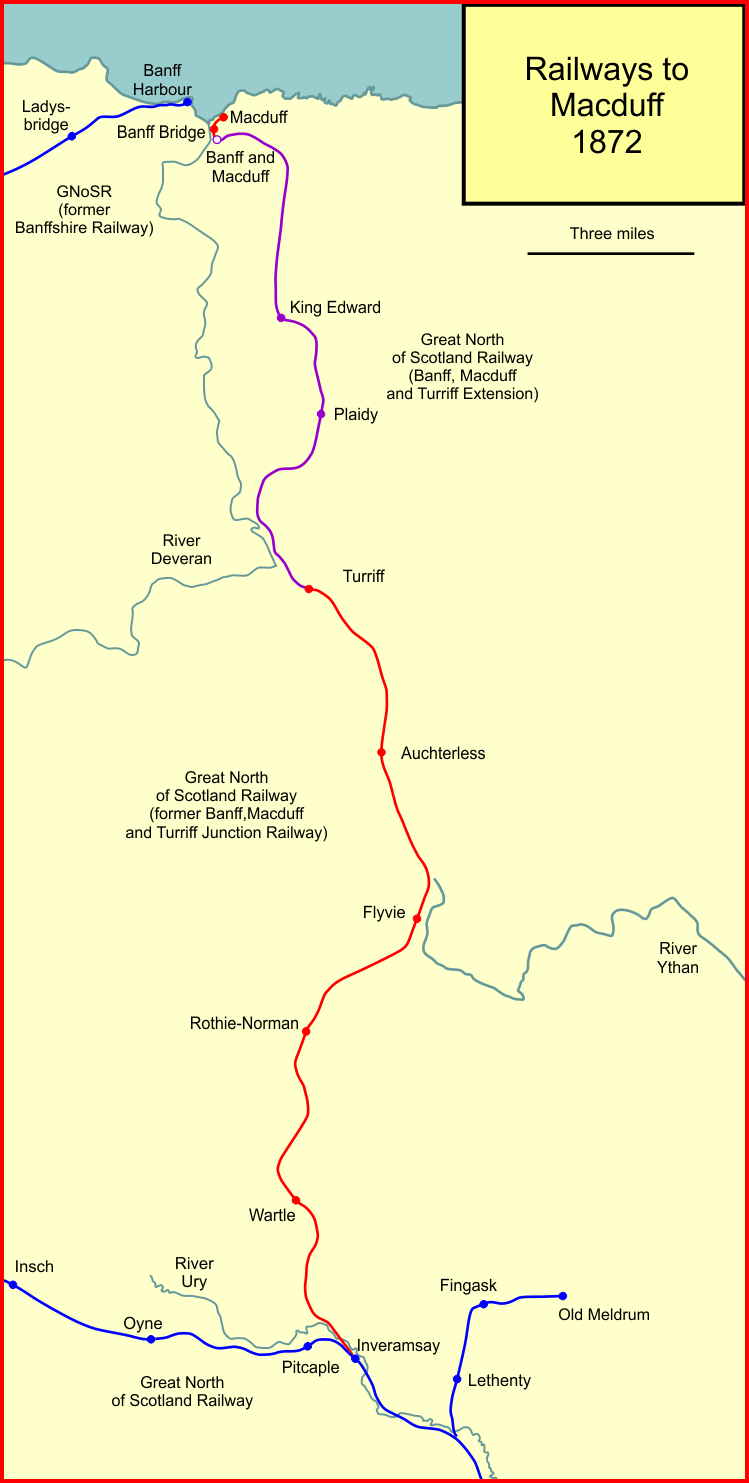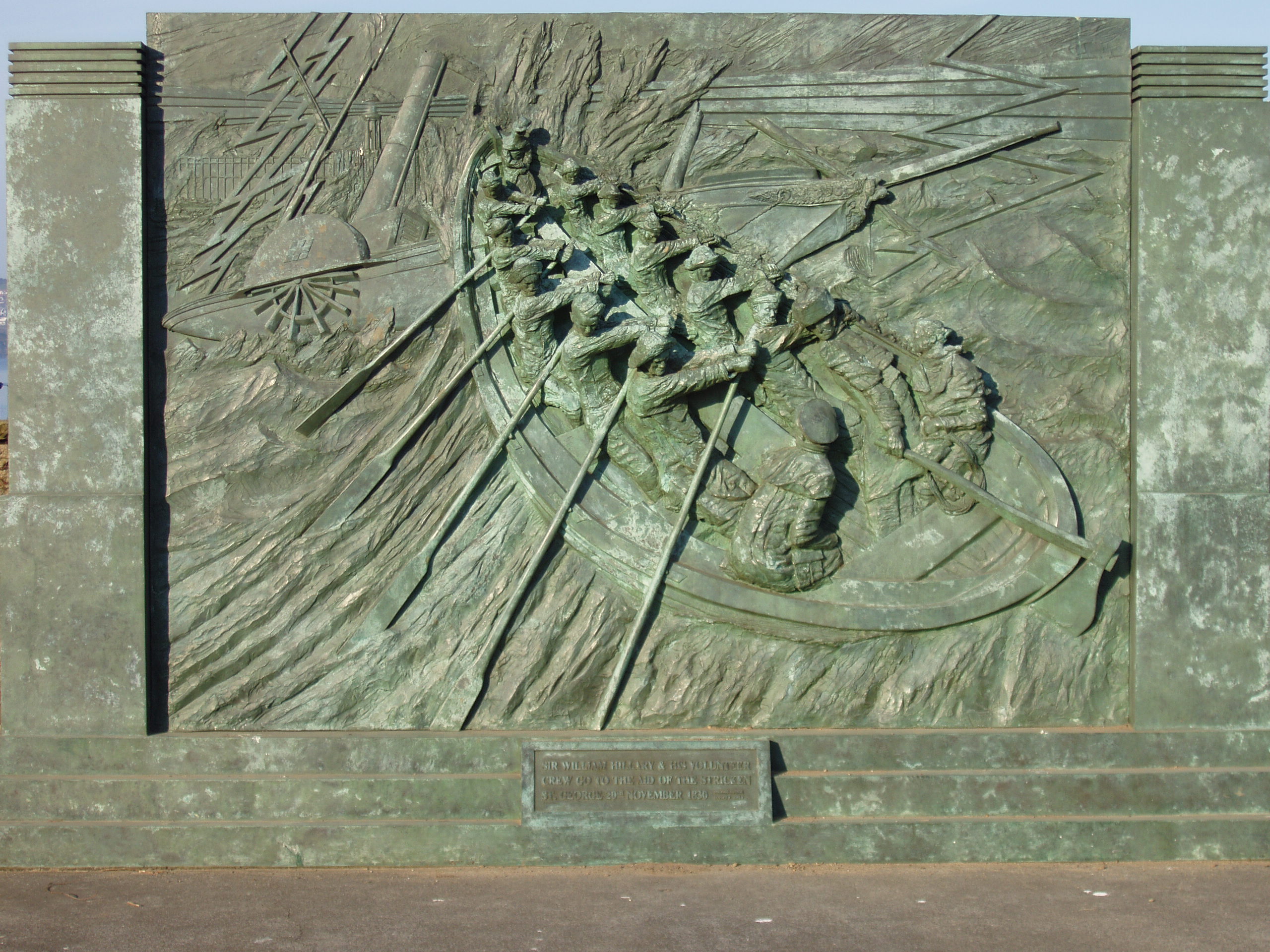|
Macduff, Aberdeenshire
Macduff ( gd, An Dùn) is a town in the Banff and Buchan area of Aberdeenshire, Scotland. It is situated on Banff Bay and faces the town of Banff across the estuary of the River Deveron. Macduff is a former burgh and was the last place in the United Kingdom where deep-water wooden fishing boats were built. History The settlement of Doune (from the Scottish Gaelic , "hill fort") was purchased in 1733 by William Duff, who became the first Earl Fife. In 1760, James Duff, the second earl, built a harbour there and in 1783 succeeded in raising Doune to the status of a burgh of barony, renaming it " Macduff" after his supposed ancestor. The 2nd Earl Fife appointed his factor, William Rose, as the first Provost of Macduff in 1783. The town celebrated its bicentenary in 1983, and the signs erected in that year still stand on the main approaches to the town (most visibly, a large sign next to the Banff Bridge on the Macduff side). Banff and Macduff are separated by the valley of th ... [...More Info...] [...Related Items...] OR: [Wikipedia] [Google] [Baidu] |
Aberdeenshire
Aberdeenshire ( sco, Aiberdeenshire; gd, Siorrachd Obar Dheathain) is one of the 32 Subdivisions of Scotland#council areas of Scotland, council areas of Scotland. It takes its name from the County of Aberdeen which has substantially different boundaries. The Aberdeenshire Council area includes all of the area of the Counties of Scotland, historic counties of Aberdeenshire and Kincardineshire (except the area making up the City of Aberdeen), as well as part of Banffshire. The county boundaries are officially used for a few purposes, namely land registration and Lieutenancy areas of Scotland, lieutenancy. Aberdeenshire Council is headquartered at Woodhill House, in Aberdeen, making it the only Scottish council whose headquarters are located outside its jurisdiction. Aberdeen itself forms a different council area (Aberdeen City). Aberdeenshire borders onto Angus, Scotland, Angus and Perth and Kinross to the south, Highland (council area), Highland and Moray to the west and Aber ... [...More Info...] [...Related Items...] OR: [Wikipedia] [Google] [Baidu] |
John Smeaton
John Smeaton (8 June 1724 – 28 October 1792) was a British civil engineer responsible for the design of bridges, canals, harbours and lighthouses. He was also a capable mechanical engineer and an eminent physicist. Smeaton was the first self-proclaimed "civil engineer", and is often regarded as the "father of civil engineering".Mark Denny (2007). "Ingenium: Five Machines That Changed the World". p. 34. JHU Press. He pioneered the use of hydraulic lime in concrete, using pebbles and powdered brick as aggregate. Smeaton was associated with the Lunar Society. Law and physics Smeaton was born in Austhorpe, Leeds, England. After studying at Leeds Grammar School he joined his father's law firm, but left to become a mathematical instrument maker (working with Henry Hindley), developing, among other instruments, a pyrometer to study material expansion. In 1750, his premises were in the Great Turnstile in Holborn. He was elected a Fellow of the Royal Society in 1753 and in 1 ... [...More Info...] [...Related Items...] OR: [Wikipedia] [Google] [Baidu] |
Great North Of Scotland Railway
The Great North of Scotland Railway (GNSR) was one of the two smallest of the five major Scottish railway companies prior to the 1923 Grouping, operating in the north-east of the country. Formed in 1845, it carried its first passengers the from Kittybrewster, in Aberdeen, to Huntly on 20 September 1854. By 1867 it owned of line and operated over a further . The early expansion was followed by a period of forced economy, but in the 1880s the railway was refurbished, express services began to run and by the end of that decade there was a suburban service in Aberdeen. The railway operated its main line between Aberdeen and and two routes west to , connections could be made at both Keith and Elgin for Highland Railway services to Inverness. There were other junctions with the Highland Railway at and , and at Aberdeen connections for journeys south over the Caledonian and North British Railways. Its eventual area encompassed the three Scottish counties of Aberdeenshire, Banffs ... [...More Info...] [...Related Items...] OR: [Wikipedia] [Google] [Baidu] |
Banff, Macduff And Turriff Junction Railway
The Banff, Macduff and Turriff Junction Railway was a railway company that connected the Aberdeenshire town of Turriff with the main line of the Great North of Scotland Railway (GNoSR) at Inveramsay. It had earlier been intended to reach Macduff, but shortage of finance forced curtailment. It opened its line in 1857. A separate company, the Banff, Macduff and Turriff Extension Railway, was formed to build an extension to Macduff. There was a road bridge connecting Macduff with Banff, crossing the River Deveron, and it was intended that both towns would be served by the railway’s terminus. The Extension Railway opened in 1860, but its terminus was some distance short of Macduff and of the bridge to Banff. Both railways were absorbed by the Great North of Scotland Railway in 1866, and the line was extended by the GNoSR to a new station in 1872, with an intermediate station at the river bridge. The companies and the branch line were never commercially successful. In 1951 the li ... [...More Info...] [...Related Items...] OR: [Wikipedia] [Google] [Baidu] |
Royal National Lifeboat Institution
The Royal National Lifeboat Institution (RNLI) is the largest charity that saves lives at sea around the coasts of the United Kingdom, the Republic of Ireland, the Channel Islands, and the Isle of Man, as well as on some inland waterways. It is one of Independent lifeboats in Britain and Ireland, several lifeboat services operating in the same area. Founded in 1824 as the National Institution for the Preservation of Life from Shipwreck, soon afterwards becoming the Royal National Institution for the Preservation of Life from Shipwreck, under the patronage of King George IV. On 5 October 1854, the institution’s name was changed to its current name (RNLI), and in 1860 was granted a royal charter. The RNLI is a charity in the UK and in the Republic of Ireland and has enjoyed royal patronage since its foundation, the most recent being Elizabeth II of the United Kingdom, Queen Elizabeth II until her death on 8 September 2022. The RNLI is principally funded by Will (law), legacie ... [...More Info...] [...Related Items...] OR: [Wikipedia] [Google] [Baidu] |
RNLI
The Royal National Lifeboat Institution (RNLI) is the largest charity that saves lives at sea around the coasts of the United Kingdom, the Republic of Ireland, the Channel Islands, and the Isle of Man, as well as on some inland waterways. It is one of several lifeboat services operating in the same area. Founded in 1824 as the National Institution for the Preservation of Life from Shipwreck, soon afterwards becoming the Royal National Institution for the Preservation of Life from Shipwreck, under the patronage of King George IV. On 5 October 1854, the institution’s name was changed to its current name (RNLI), and in 1860 was granted a royal charter. The RNLI is a charity in the UK and in the Republic of Ireland and has enjoyed royal patronage since its foundation, the most recent being Queen Elizabeth II until her death on 8 September 2022. The RNLI is principally funded by legacies (65%) and donations (28%), with the remainder from merchandising and investment. Most of th ... [...More Info...] [...Related Items...] OR: [Wikipedia] [Google] [Baidu] |
Listed Building
In the United Kingdom, a listed building or listed structure is one that has been placed on one of the four statutory lists maintained by Historic England in England, Historic Environment Scotland in Scotland, in Wales, and the Northern Ireland Environment Agency in Northern Ireland. The term has also been used in the Republic of Ireland, where buildings are protected under the Planning and Development Act 2000. The statutory term in Ireland is " protected structure". A listed building may not be demolished, extended, or altered without special permission from the local planning authority, which typically consults the relevant central government agency, particularly for significant alterations to the more notable listed buildings. In England and Wales, a national amenity society must be notified of any work to a listed building which involves any element of demolition. Exemption from secular listed building control is provided for some buildings in current use for worship, ... [...More Info...] [...Related Items...] OR: [Wikipedia] [Google] [Baidu] |
Macduff Town Hall
Macduff Town Hall is a municipal building in Shore Street, Macduff, Aberdeenshire, Scotland. The structure, which was the meeting place of Macduff Burgh Council, is a Category B listed building. History The first municipal building in Macduff was an early 19th century townhouse in Shore Street. Following significant population growth, largely associated with the fishing industry, the town became a police burgh in 1853. In the 1880s, the police commissioners decided to demolish the old townhouse and erect a new building in its place. The new building was designed by John Bridgeford Pirie and Arthur Clyne in the Scottish baronial style, built in ashlar stone and completed in 1885. The design involved a symmetrical main frontage with three bays facing onto Shore Street; the central bay, which slightly projected forward, featured a doorway with a fanlight on the ground floor, a sash window on the first floor and a Diocletian window with a blind oculus above at attic level. The centr ... [...More Info...] [...Related Items...] OR: [Wikipedia] [Google] [Baidu] |
Town Hall (geograph 3923022)
In local government, a city hall, town hall, civic centre (in the UK or Australia), guildhall, or a municipal building (in the Philippines), is the chief administrative building of a city, town, or other municipality. It usually houses the city or town council, its associated departments, and their employees. It also usually functions as the base of the mayor of a city, town, borough, county or shire, and of the executive arm of the municipality (if one exists distinctly from the council). By convention, until the middle of the 19th century, a single large open chamber (or "hall") formed an integral part of the building housing the council. The hall may be used for council meetings and other significant events. This large chamber, the "town hall" (and its later variant "city hall") has become synonymous with the whole building, and with the administrative body housed in it. The terms "council chambers", "municipal building" or variants may be used locally in preference ... [...More Info...] [...Related Items...] OR: [Wikipedia] [Google] [Baidu] |
Pennan
Pennan ( sco, Peenan) is a small village in Aberdeenshire, Scotland, consisting of a small harbour and a single row of homes, including a hotel. It is on the north-facing coast and is about one hour's drive from Aberdeen. It was formerly known as St Magnus Haven or Auchmedden. Etymology The name ''Pennan'' was recorded in 1587 as ''Pennand''. It is possibly derived from the Brittonic element ''*pen'' meaning "head, end, promontory" ( Welsh ''pen''). Area history Pennan seems to have come into existence as a fishing village in the 18th century. The people of Pennan were dependent on the sea. Most families had small boats for their own personal use. Where the men would catch the fish, it was usually down to the women and children to try to sell it to clients in the country. Until the 1930s, the population of the village seems to have come under three main surnames - Watt, Gatt and West. In the last 50 years, most of the native families have moved out and most of the houses have ... [...More Info...] [...Related Items...] OR: [Wikipedia] [Google] [Baidu] |
Gardenstown
Gardenstown ( sco, Gamrie) is a small coastal village, by road east of Banff in Aberdeenshire, northeastern Scotland. The village's main economic base is fishing. Gardenstown is served by Gardenstown New Church. The hamlet of Dubford is to the south, and a footpath along the shore to the east leads to the village of Crovie. History There is evidence of Neolithic or Bronze Age peoples having settled in the vicinity of Gardenstown; notably at Longman Hill and Cairn Lee. Nearby are the remains of the Church of St John the Evangelist which was built in 1513, and celebrates the defeat of the Danes at this site in 1004 in the Battle of the Bloody Pits. Gardenstown and its harbour were founded in 1720 by Alexander Garden.''Ordnance Gazetteer of Scotland ... [...More Info...] [...Related Items...] OR: [Wikipedia] [Google] [Baidu] |
Tarlair Swimming Pool
Tarlair Swimming Pool is a disused lido at the base of a sea cliff just outside Macduff in Aberdeenshire in Scotland. This outdoor swimming complex was built in an Art Deco style with a main building backing onto the cliffs and changing rooms to its left hand side. It is considered by Historic Environment Scotland to be the best example of only three surviving outdoor seaside pools in Scotland, the others being at Stonehaven and Gourock. The design of the pool was a clever use of pumped sea water to fill the pools, and flooding of the main pool at high tide to flush out the old water. The main pool had a diving board at the deep end and a child's chute at the shallow end, though both are now missing. The second-largest pool was a boating pool with the two remaining pools being paddling pools. The complex is now in some disrepair with a mixture of weathering, rock falls and vandalism being the main causes. Channel 4 television made "Tarlair Outdoor Pool" the subject of the thir ... [...More Info...] [...Related Items...] OR: [Wikipedia] [Google] [Baidu] |










